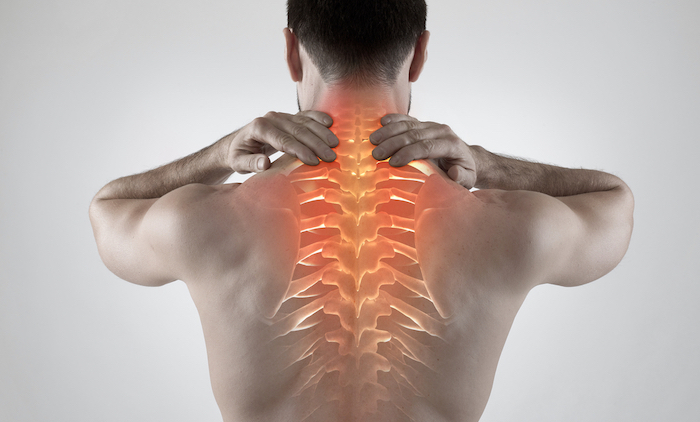
A herniated disc in the upper back, also called a thoracic herniated disc, can cause a variety of symptoms including pain, numbness, and weakness. While sharp, axial back pain that worsens with activity is most common, other signs and symptoms can include:
- Burning and/or electric-like pain that localizes to the back or radiates circumferentially around the chest or abdomen.
- Similar shock-like pain can radiate into the legs.
- Sensory disturbances, including tingling and numbness, may be experienced at or below the level of the herniated disc.
- Motor deficits such as leg weakness and gait instability can also be observed.
- In the most severe cases, paralysis of the legs and bowel and/or bladder dysfunction can occur.
Read on to learn how a thoracic herniated disc is capable of causing such a wide range of signs and symptoms.
Pain From a Thoracic Herniated Disc
There are 12 intervertebral discs in the thoracic spine that help support and cushion the vertebrae in the mid-back region.1 A herniated disc occurs when the disc’s tough outer layer (annulus fibrosus) tears and the jelly-like inner core (nucleus pulposus) bulges or becomes extruded.
Various types of pain may develop due to a thoracic herniated disc, including:
- Discogenic pain. A ruptured or torn annulus fibrosis with surrounding inflammation in the connective tissues of the disc itself may result in back pain localizing to the injured level. This type of pain can be misinterpreted as cardiac, pulmonary, or abdominal pain.
- Muscle spasm. Local injuries to the intervertebral disc and supporting ligaments can trigger protective responses by the surrounding muscles. The large muscles in the back can tighten and eventually go into spasm. Pain from muscle spasms can affect a large region across multiple levels of the back and restrict the range of motion or make it difficult to stand upright.
- Radicular pain. A herniated thoracic disc with a lateral component may compress or irritate the nerves innervating the chest wall around the ribs and abdomen. This pain is typically unilateral and described as burning or electric shock-like, but it can also feel achy or mild. In some cases, this pain can feel like a band around the chest or abdomen.
The direction of Disc Herniation
The signs and symptoms of a thoracic herniated disc largely depend on which direction the herniation occurs.
- A lateral herniation is extruded to one side, which may affect a nerve root where it exits the spine and results in radicular pain.
- A central herniation is extruded directly into the center of the spinal canal, which may cause spinal canal stenosis and compress the spinal cord.
- A Centro-lateral herniation is extruded to the side and into the center of the canal, which may affect both the nerve root and the spinal cord.
A thoracic disc herniation most commonly occurs toward the bottom of the thoracic spine (from T8 to T12) as this is the most mobile segment of this region.2,3
Numbness And Weakness from A Thoracic Herniated Disc
While rare, neurological deficits from a thoracic herniated disc can be serious and require medical consultation.
Thoracic radiculopathy
When a thoracic herniated disc compresses or irritates a nearby nerve root as it branches off the spinal cord en route to exiting the central canal, it can cause thoracic radiculopathy. Thoracic radiculopathy may consist of tingling, numbness, and/or pain that radiates into the chest or abdomen.
Thoracic myelopathy
When a thoracic herniated disc compresses the spinal cord, it can cause thoracic myelopathy. Possible signs may include tingling and numbness experienced anywhere at the level of the herniated disc or below including the feet and/or weakness in the legs. As myelopathy progresses, problems with coordination, walking, spasticity, sensation around the saddle region, and/or bowel and bladder dysfunction (incontinence) may develop.
Thoracic herniated disc pain typically improves within 6 to 12 weeks of nonsurgical care. Unilateral radiculopathies can often be managed without surgery as well. Any progressive or new neurological deficits, such as radiating pain, numbness, weakness, gait instability, bowel or bladder dysfunction require immediate medical attention.
Precision Pain Care and Rehabilitation has two convenient locations in Richmond Hill – Queens and New Hyde Park – Long Island. Call the Richmond Hill office at (718) 215-1888, or (516) 419-4480 for the Long Island office, to arrange an appointment with our Interventional Pain Management Specialist, Dr. Jeffrey Chacko.













